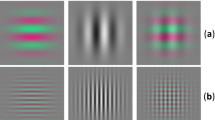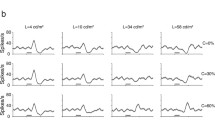Summary
The mechanisms that produce simultaneous contrast have been thought to depend on retinal gain control and the retina is supposed to send signals to the brain only in terms of local-border contrast (Shapley, 1986). However, it was found that, when an object on a uniform background and border-concealing stimuli are presented to different eyes, the brightness of the object is greatly influenced if the border-concealing stimuli are perceptually superimposed on the border of the object. The change in the object's brightness in this condition is almost identical to that observed when both the object and the border-concealing stimuli are presented to the same eye, suggesting that the brain can compute brightness by using luminosity information when contrast information is disrupted.
Similar content being viewed by others
References
Asher, H. (1950). Contrast in eye and brain.British Journal of Psychology, 49, 187–194.
Barlow, H. B., & Levick, W. R. (1969). Changes in maintained discharge with adaptation level in the cat retina.Journal of Physiology, 202, 699–718.
Burr, D. C. (1987). Implications of the Craik-O'Brien illusion for brightness perception.Vision Research, 27, 1903–1913.
Enroth-Cugell, C., & Robson, J. G. (1966). The contrast sensitivity of retinal ganglion cells of the cat.Journal of Physiology, 187, 517–552.
Frisby, J. P. (1979).Seeing. Oxford: Oxford University Press.
Gilchrist, A. L. (1977). Perceived lightness depends on perceived spatial arrangement.Science, 195, 185–187.
Heinemann, E. G. (1955). Simultaneous brightness induction as a function of inducing- and test-field luminances.Journal of Experimental Psychology, 50, 89–96.
Heinemann, E. G. (1972). Simultaneous brightness induction. In D. Jameson & L. Hurvich (Eds.),Handbook of sensory physiology (Vol. VII/4). Berlin, Heidelberg, New York: Springer.
Hubel, D. H., & Wiesel, T. N. (1962). Receptive fields, binocular interaction, and functional architecture in the cat's visual cortex.Journal ofPhysiology, 160, 106–154.
Land, E. H., Hubel, D. H., Livingstone, M. S., Perry, S. H., & Burns, M. M. (1983). Colour-generating interactions across the corpus callosum.Nature, 303, 616–618.
Levelt, W. J. M. (1965). Binocular brightness averaging and contour information.British Journal of Psychology, 56, 1–13.
Sakmann, B., & Creutzfeld, O. D. (1969). Scotopic and mesopic light adaptation in the cat retina.Pflügers Archiv für die Gesamte Physiologie des Menschen und der Tiere, 313, 168–185.
Sclar, G., Maunsell, J. H. R., & Lennie, P. (1990). Coding of image contrast in central visual pathways of the macaque monkey.Vision Research, 30, 1–10.
Shapley, R. (1986). The importance of contrast for the activity of single neurons, the VEP and perception.Vision Research, 26, 45–61.
Shapley, R., & Enroth-Cugell, C. (1984). Visual adaptation and retinal gain controls. In N. N. Osborne & G. J. Chader (Eds.),Progress in retinal research (pp. 263–346). Oxford: Pergamon Press.
Shapley, R., & Reid, R. C. (1985). Contrast and assimilation in the perception of brightness.Proceedings of National Academy of Science U. S. A., 82, 5983–5986.
Author information
Authors and Affiliations
Rights and permissions
About this article
Cite this article
Sugita, Y., Mimura, K. Cortical modulation of visual contrast. Psychol. Res 53, 271–273 (1991). https://doi.org/10.1007/BF00920479
Received:
Accepted:
Issue Date:
DOI: https://doi.org/10.1007/BF00920479




